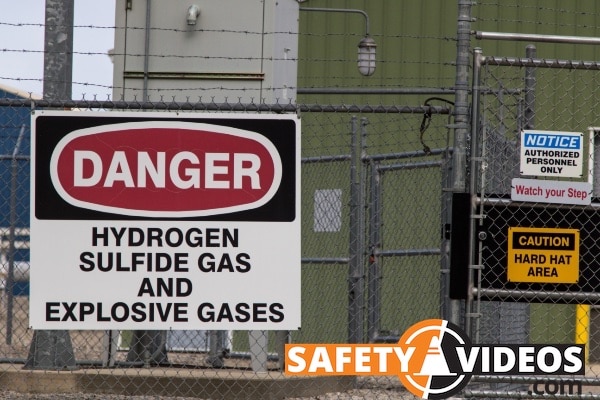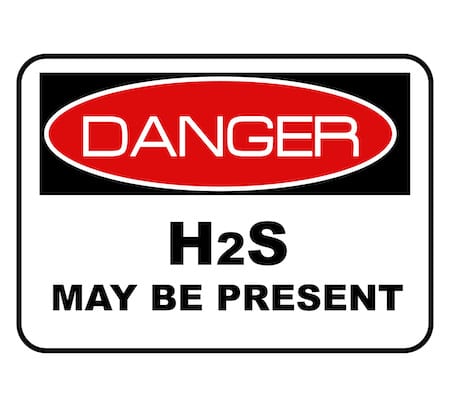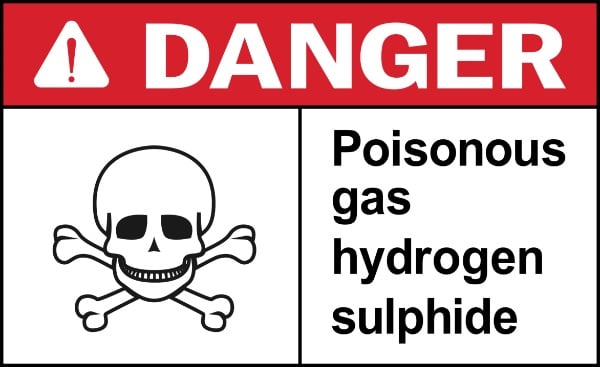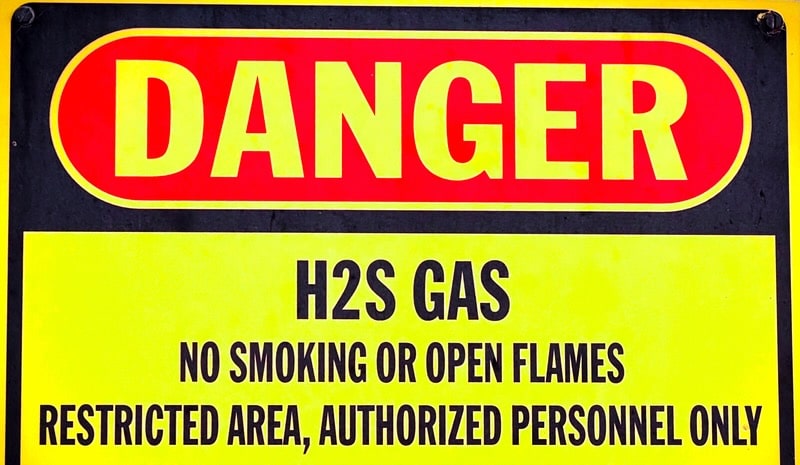H2S Toolbox Talk – Quick & Easy [Updated for 2023]

Hydrogen sulfide (H2S) is a type of gas that is heavier than air. The gas sometimes occurs naturally or can be a by-product of industrial procedures and activities. The gas is toxic, and thus it has many health hazards for industrial workers.
Teaching your employees how to remain safe against this deadly gas is critical, so we created this short H2S Toolbox Talk. You can have a quick safety meeting with your team using this information to educate your staff.
Sadly, several employees have experienced significant health impacts, and even death, after being exposed to hydrogen sulfide, so safety should be top of mind for all employees. It is essential for employees working in industrial zones where the gas may be produced to be aware of its characteristics, risks, and effects on health. Workers also need to know the best safety practices for work zones where they may come into contact with H2S.
In addition to this toolbox talk, we also have a video-based H2S Safety Training program.
Hydrogen Sulfide Features
Hydrogen sulfide is typically a colorless gas, but it can be recognized by its unpleasant “rotten egg” smell in lower concentrations. When the gas concentration is denser, however, it affects one’s sense of smell, and the gas is not so easily detected by smell anymore.
This means the sense of smell cannot always be relied on to detect the presence of H2S. If you want a deeper understanding of this gas, please refer to our deeper dive on h2s.

Weight
The gas is heavier than oxygen or air. This means it tends to sink to lower industrial or factory zone areas. It may be in more significant quantities in low-lying zones, confined spaces, and poorly ventilated areas like pits, basements, or underground vaults.
Hazardous Features
The gas has several features or characteristics that make it hazardous to workers’ health. When the gas is burned, it releases other toxic fumes like sulfur dioxide.
Even at very low concentrations, the gas can impact one’s health. Concentrations as low as two to five parts per million (ppm) will pose a health risk, especially if workers are exposed to the gas for an extended period of time.
H2S is Flammable
The gas is also highly flammable, which poses a severe fire risk, especially in low-lying areas where the gas occurs in higher concentrations. The gas is known to react with steel to create iron sulfide. This can then ignite if it is exposed to the air.
This fire hazard can impact people, expensive industrial equipment, and buildings.
How Hydrogen Sulfide Gas is Produced
There are several ways H2S can be released. Besides being a natural gas, hydrogen sulfide occurs in crude petroleum and other industrial processes.
Metal Fatigue
Hydrogen sulfide gas can also be produced when old metals begin to corrode and break down. These processes are metal fatigue, sulfide stress cracking, or hydrogen embrittlement. H2S can be released when metals go through these breakdown processes.
Waste Matter
H2S can also be produced during the breakdown of organic matter waste from animals and humans. Thus, it may be present in sewer gas, sewer lines, and manure pits.

Types of Hydrogen Sulfide Exposure
We talk about two main kinds of exposure when it comes to hydrogen sulfide. The first is acute exposure. This means that a person was quickly exposed to a large amount of H2S.
The second type is chronic exposure. This term refers to when a person is exposed to lesser amounts of this gas over a long period.
The Health Reactions to Concentrations of Hydrogen Sulfide
Hydrogen sulfide is highly toxic and heavier than air, making it common and condensed in low-lying places that aren’t well-ventilated. People exposed to H2S, even in low concentrations, can experience various health issues. The level of exposure also impacts the kinds of reactions a person may experience. These reactions to the gas include:
- Severe eye, nose, and throat irritation, especially when exposed to low concentrations.
- Headaches and coughing may occur.
- Respiratory system reactions may occur. It interferes with the natural, effective oxygen utilization in a person’s central nervous system. This may cause difficulty breathing for a person exposed to the gas.
- Irrational behavior may be noted at low to moderate exposure levels.
- Exposure to moderate concentrations of H2S may cause feelings of dizziness, as well as nausea and vomiting.
- Exposure to high concentrations of hydrogen sulfide may cause loss of consciousness very quickly, which can worsen to coma and even death.
How to Keep Employees Safe from Hydrogen Sulfide Hazards
All employees should undergo company training about hydrogen sulfide to keep workers in industrial zones safe from this highly hazardous gas. This training should include what processes of the company produce the gas, how to test for it, how to respond to its possible and actual presence and its range of hazards. Refer to this OSHA guide for additional talking points and information.
Workplace practices to ensure safety from hydrogen sulfide hazards should also be followed conscientiously and consistently. These practices include:
- Initially, check any prospective work area for the smell of rotten eggs, indicating the presence of hydrogen sulfide gas.
- Marking off any areas where H2S gas may be present.
- Before any work is undertaken, test all low-lying zones, poorly ventilated areas, confined spaces for H2S, and any other dangerous gases.
- Should gas concentrations be found when testing, they should be removed before work can take place. The area may need continuous ventilation systems if the company’s industrial procedures frequently produce gas.
- If H2S concentrations are less than 100ppm, workers may be given full-face respiratory masks equipped with air-purifying cartridges to protect them while they work.
- In higher concentrations, that is, over 100ppm, the concentration of H2S gas is considered immediately dangerous and thus too risky to health and life to work in. These zones must be avoided until the gas has been professionally removed.
- High-tech masking systems or self-contained breathing apparatus must be provided if, for any reason, entry into these zones cannot be avoided, i.e., in the case of rescue operations.
- Facilities in which the production of H2S is a frequent occurrence should have alarm systems set up to make workers aware of the presence of hydrogen sulfide.

Other H2S Protocols
Other company protocols, such as the following, should be in place to manage circumstances where H2S may be present:
- An emergency plan should be in place should an incident concerning H2S occur. Employees should be aware of and follow this company emergency plan in case of a safety risk.
- Workers needing to work in H2S zones should be “fit tested” to do so.
- A doctor should thoroughly examine any employees exposed to H2S before returning to work.
H2S Safety Save Lives
This section shows that safety practices regarding toxic gases like H2S are essential. Fewer accidents reduce costs for a company, but more importantly, it keeps workers healthy. If a worker experiences health issues due to exposure to high concentrations of H2S, it can cost many hours of treatment and rehabilitation without guaranteeing a full recovery.
While following procedures isn’t always convenient, cutting corners could mean the end of a life as someone knows it or life altogether.
Share This H2S Toolbox Talk
Hydrogen sulfide safety in the workplace is a serious matter. Exposure to H2S gas can cause severe health issues and even death. Thus, it is essential for all employees in industries where the presence of gas can occur to be made aware of the risks and how to deal with them.
All industrial enterprises where hydrogen sulfide may be released should have industry-approved protocols, processes, and equipment to deal with H2S risks. Hopefully, this hydrogen sulfide toolbox talk will help you and your employee stay safe if you work around this dangerous gas.